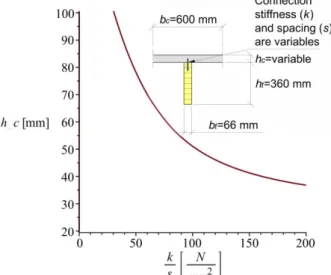46
ISBN: 978-91-88898-64-7
Multi-Objective and Multi-Criteria Approach for Value-Driven Design in
Industrialized Residential Multi-Storey Timber-Building
*Hamid Movaffaghi†, Johan Pyykkö‡, and Ibrahim Yitmen †
†Department of Construction Engineering and Lighting Science, Jönköping University, Jönköping, Sweden,
hamid.movaffaghi@ju.se and ibrahim.yitmen@ju.se
‡ University of Borås – Faculty of Textiles, Engineering and Business
Uppsala University – Division of Applied Mechanics, Ångström Laboratory, johan.pyykko@hb.se
Serviceability in terms of springiness, vibration and deflection [1], as well as sustainability in terms of climate impact and costs [2] have been identified as the most important aspects for appropriate functioning in residential multi-storey timber-buildings. Thus, the aim of this study is focused on product development of a timber-concrete composite (TCC) floor system by 1) enhancing serviceability performances of the floor for larger spans (above 6 m) in terms of stiffness and dynamic response, and 2) reducing both climate impact (CO2-emissions) and costs, by optimizing material usage. As the case study a timber structure of a residential multi-storey building, including concrete ground floor and shaft, with the overall dimensions 30 11 14 has been studied. The geometry of the load bearing structural elements has been modelled using finite element programs. As serviceability criteria for the floors, the deflection due to a point load was chosen. The deflections were related to comfort classes given in [3] and transverse load distribution was taken into account according to [4]. The deflection and effective bending stiffness (EIef in EC5 Annex B) were chosen as objective functions, while thickness of concrete slab and shear stiffness of the connection between glulam beam and concrete slab were chosen as design variables in a multi-objective optimization. The relationship between connection stiffness and height of the concrete slab for comfort class B can be seen in Figure 1. In the figure the cross-section of the TCC floor structure, with a span of 7.5 m, is also depicted.
Figure 1: Connection stiffness-concrete thickness relationship and cross-section for the TCC floor.
After optimization, a multi-criteria analysis was applied to select a design solution from the Pareto optimal front, satisfying some subjective preferences of the stakeholders for value-driven design. The results in this study integrates serviceability, environmental and economic performances for value-driven design and supports decision making in the early phases of a project, where various alternatives can be analyzed and evaluated.
References
[1] L. J. Hu, Y. H. Chui, & D. M. Onysko: Vibration serviceability of timber floors in residential construction. Progress
in Structural Engineering and Materials, 3(3) (2001), 228–237.
[2] H. Movaffaghi, I. Yitmen: Developing a framework of a multi-objective and multi-criteria based approach for integration of LCA-LCC and dynamic analysis in industrialized multi-storey timber construction. 35th CIB W78 2018 Conference: IT in Design, Construction, and Management, Chicago, 01-03 October 2018.
[3] K. Jarnerö: Vibrations in timber floors- Dynamic properties and human perception, Doctoral thesis, ISBN: 978-91-87925-23-8, Linnaeus University Press, 351 95 Växjö, Sweden, 2014.
[4] S. Ohlsson: Svikt, svängningar och styvhet hos bjälklag – dimensioneringsmetoder (in Swedish). Byggforskningsrådet, 1984.
